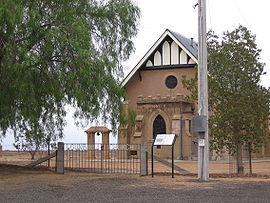Gunbar, New South Wales
|
Gunbar New South Wales |
|
|---|---|

Presbyterian church
|
|
| Coordinates | 34°03′S 145°23′E / 34.050°S 145.383°ECoordinates: 34°03′S 145°23′E / 34.050°S 145.383°E |
| Population | 97 (2006 census) |
| Postcode(s) | 2711 |
| Elevation | 95 m (312 ft) |
| Location | |
| LGA(s) | Carrathool Shire |
| County | Nicholson |
| State electorate(s) | Murray |
Gunbar is in the Riverina district of south-western New South Wales in Australia, on a wide bend of the Mid-Western Highway between Goolgowi and Hay. It is part of the Carrathool Shire local government area, administered from Goolgowi. At the 2006 census, Gunbar had a population of 97 people.
In its heyday Gunbar was a village which served as the hub of the surrounding pastoral properties and the community of selectors that had settled in the district from the 1870s onwards. Nowadays the Gunbar community consists of those who live and work on district farming properties. The Presbyterian church, still used for worship, stands on an elevated position overlooking the original village-site, where the corrugated-iron Community Hall is the only other major building that remains. Scattered peppercorn trees give further evidence of the village that once stood there. Gunbar cemetery is located just over a mile away, nearby to the site of the old government-surveyed township (NNE of the original village).
The land later known as "Gunbar" station was first occupied by Europeans during the expansion by squatters along the Lachlan River in 1839 and the early 1840s. By the early 1870s "Gunbar" and other surrounding runs were held by the partnership of G. Kirk, John Bramwell and Albert Synnot. The name "Gunbar" is said to be an Aboriginal word meaning "no meat". In 1875, after Albert Synnot's death, the "Gunbar" lease was transferred to G. Kirk and D.B. Reid. In 1876 "Gunbar" station was held by W. Cumming & Co., with John Armstrong as manager. "Gunbar" comprised an area of at least 380,000 acres (1,500 km2) during this period. In 1881 the Armstrong brothers - William, Thomas, Robert, and John - purchased the leasehold of "Gunbar" for £300,000, and John Armstrong continued as the managing partner. Stock returns for 1888 record the area of "Gunbar" station as 280,000 acres (1,100 km2), reflecting the inroads made by selectors since the mid-1870s as the district became more closely settled and the village of Gunbar was established. After John Armstrong's death in 1899 his eldest son, William, managed the station until it was sold in June 1918 to T.A. Creswick.
...
Wikipedia

